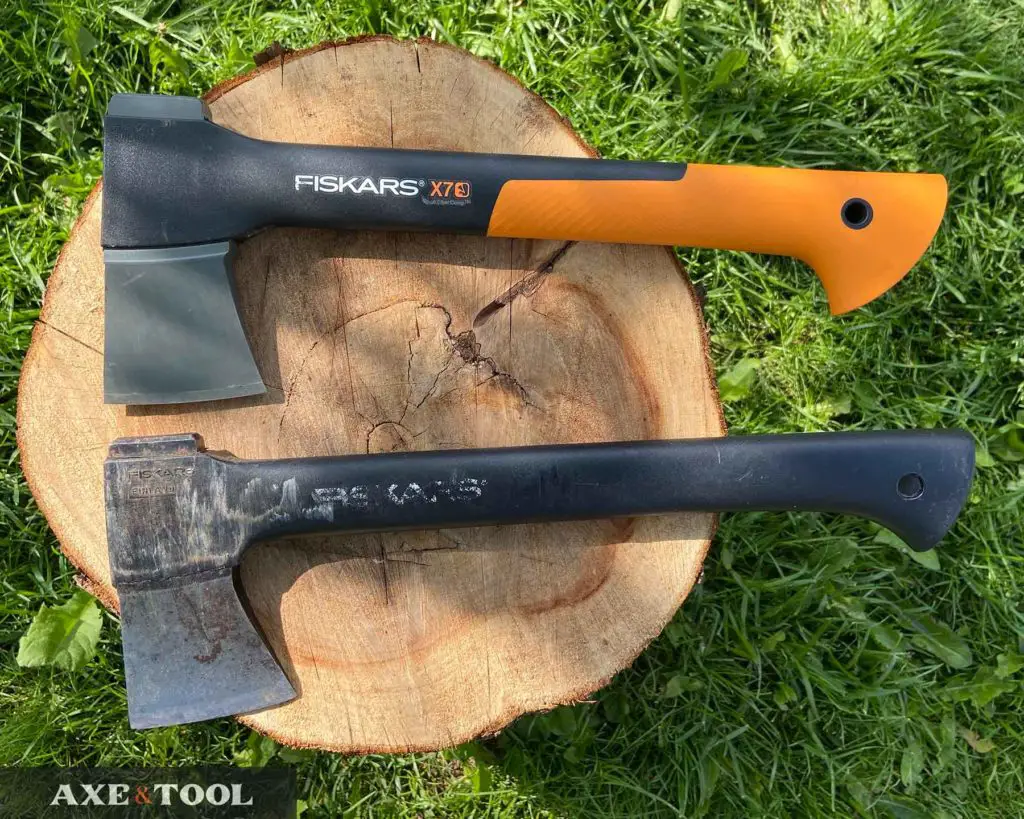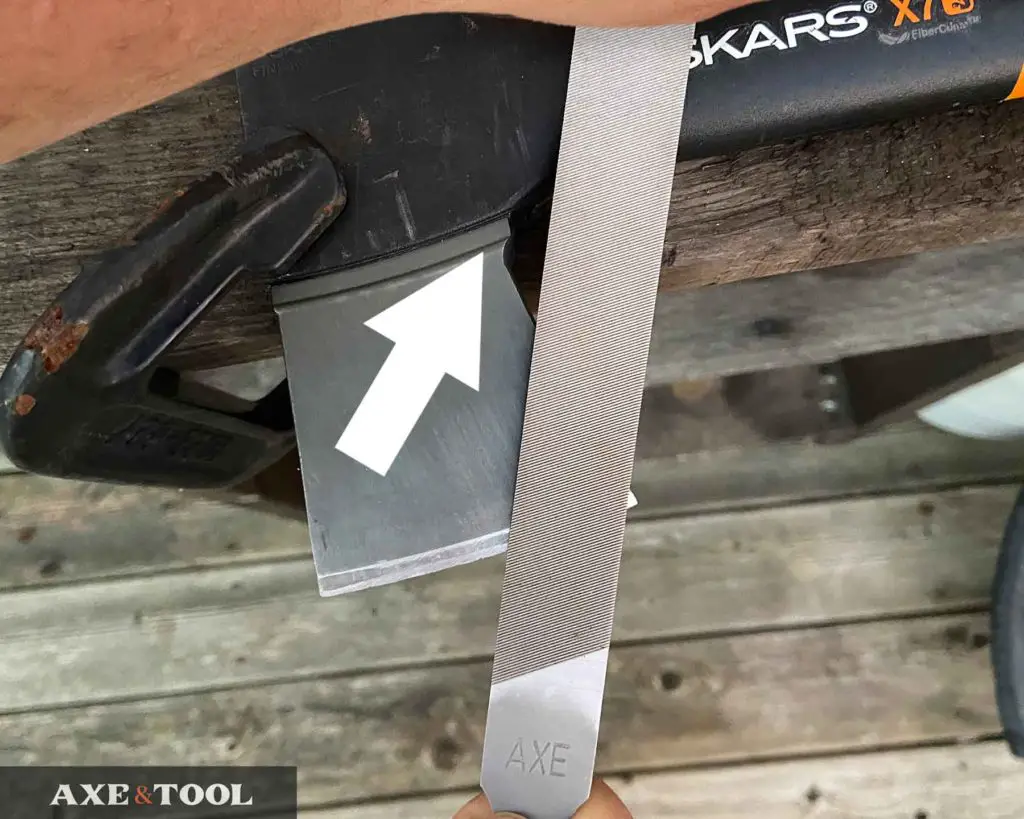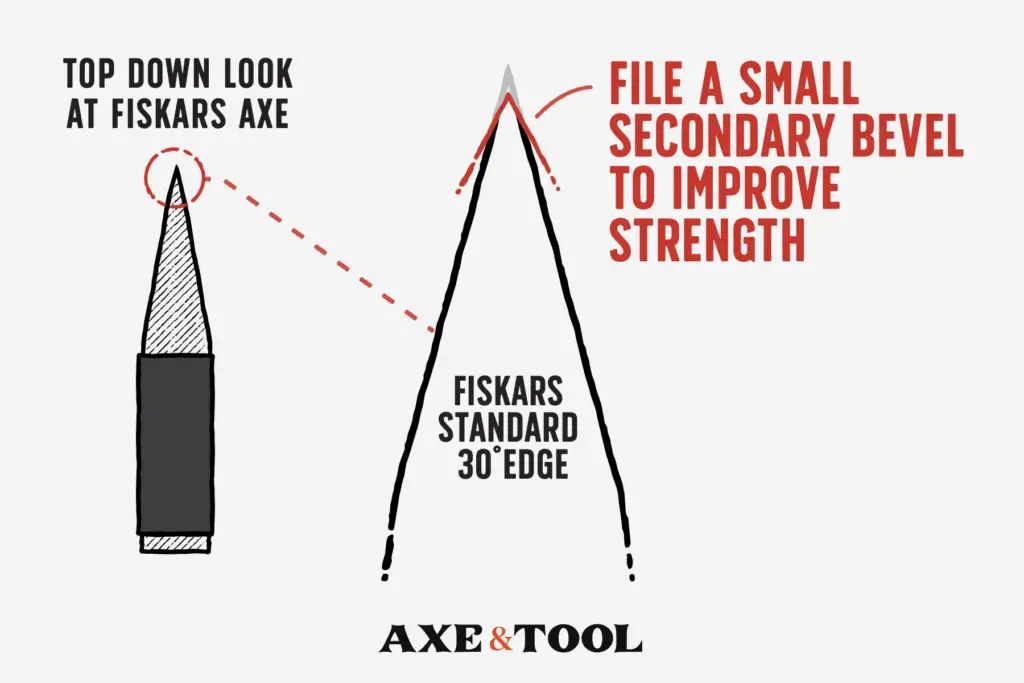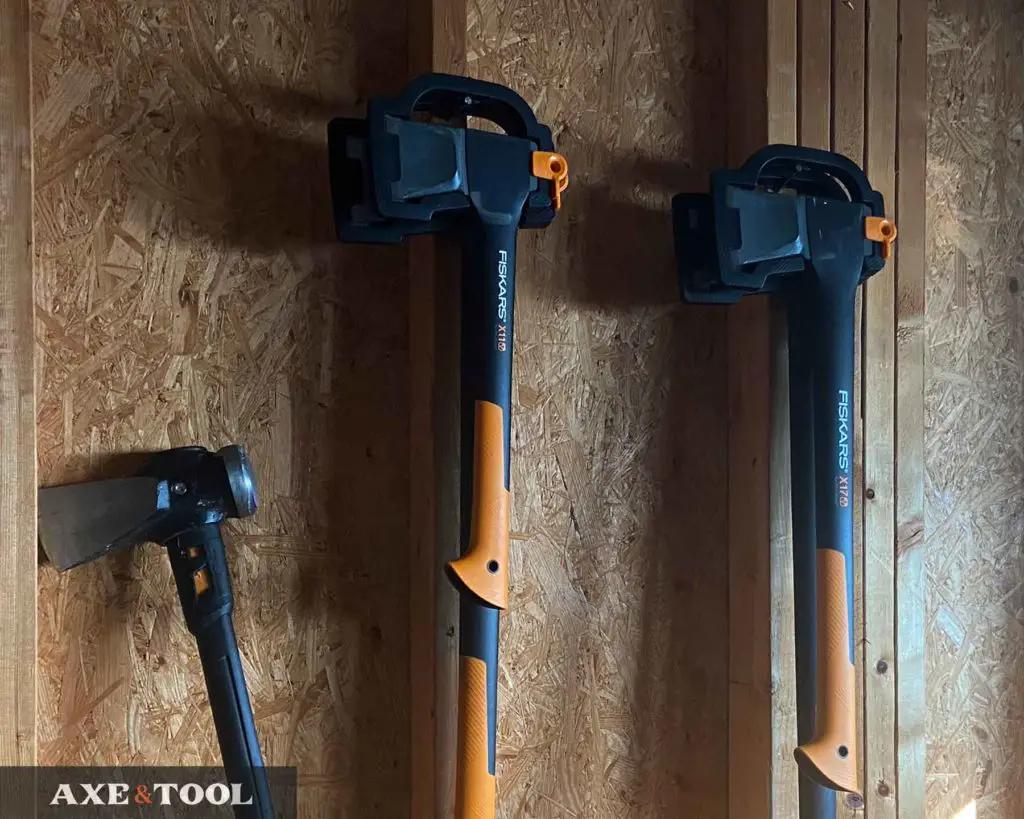Fiskars Axe Maintenance – Fixing Common Problems

I bought my first Fiskars hatchet almost 10 years ago and it’s still in use after all kinds of abuse. I now own many Fiskars axes (big and small) and the nice thing is that they will keep chopping along.
I went years with the first hatchet before doing any maintenance on it – but it’s better if you take care of them from the start.
Fiskars axes need way less maintenance than traditional wood axes. But the head is still steel, and that always needs a certain amount of rust prevention, cleaning, and sharpening.
Fiskars axes are best maintained if the blade is cleaned and oiled. The original coating on the blade will wear off with use, and it can accumulate rust. Additional sharpening will be needed after moderate use, and re-profiling the edge can make the edge more durable.
1. Cleaning & rust prevention
Fiskars axe heads come coated in grey or black Teflon-like finish to protect against moisture and rust. But it doesn’t take much use to start exposing the steel. Especially with the splitting axes, you can often see the coating rubbing off on the wood as you work.
It’s just the nature of axes. There is no such thing as a permanent coating.

This is the first day out with a new 36″ Supersplitter and you can see the coating wearing off already. It’s more obvious on the black axes, but it happens on the grey X-series as well.
The Fiskars machining process produces a series of fine grooves running along the blade that is exposed once the coating starts to wear off. These grooves can be a moisture and rust trap if not cleaned regularly and protected.
Oil the head to stop rust
1. Clean away any dirt or wood fibers from the surface of the axe head, as it will be full of moisture.
2. Apply oil to the exposed steel to keep moisture out.
The easiest way is to simply wipe down the head with WD-40 after using the axe. It will both clean away dirt and residue and provide a light oiling at the same time.
WD-40 is a common solution, but gun oil, boiled linseed oil, and other solutions work great. I have a full article on every way I know to prevent rust on an axe. One method even includes bacon.
If rust does start to form in those grooves (or anywhere on the head), I’ve found steel wool or a wire brush are the best way to get in there and clean it out.
However, with these axes, I know a lot of people don’t bother. Especially with the splitting axes – just keep swinging and sharpen as needed.
2. Maintaining the blade (bit) of your Fiskars Axe
While most of a Fiskars axe is fairly indestructible, the cutting edge will dull with use and can chip or roll. It’s a fairly common criticism of Fiskars. The 30-degree flat grind edge is sharp but more delicate than a convex grind. Combined with a bit softer steel and you are going to have to do some sharpening.
I don’t fault Fiskars for this. It’s part of the deal with a flat grind design (which comes surprisingly sharp for the price). Sharpening is just part of the axe game.
Common issues with the Fiskars axe edge
All axes will dull with use, and rolled edges can be quite common with flat ground edges (like on Fiskars).
A rolled edge is when the fine sharp point of the blade gets bent, or “rolled” to one side. It may not even be noticeable at a glance but if you touch the sides of the blade edge you will feel a thin “wire” or “lip” of metal off to the side, right at the tip.
Fixing dull blades and rolled edges can easily be done with regular sharpening. You can use a classic sharpening stone or puck, which will give you the best results (but may require some practice).

How to use a sharpening puck:
- Lay the puck at a consistent angle with your axe blade.
- Rub the sharpening puck in a tight circular motion across the entire edge of the blade (keeping the angle consistent).
- Sharpen one side of the edge before switching to the next.
- Repeat on both sides with lighter pressure
Tip: Most pucks have a course and a fine side. If the blade is just dull or rolled you can just use the fine side. But for heavily worn and nicked edges you can start with the coarse side, before going again with the fine.
Using the Fiskars axe sharpener
You can also use the Fiskars axe sharpener, which is a simple ceramic pull-through sharpener. It can’t deliver as clean an edge as a stone, but I was quite surprised by how good an edge it can produce. It’s super fast and it’s really easy to use.
I always recommend people learn to sharpen the “proper” way with stones, but it can be hard to beat an easy 60-second sharpen. See how to use the Fiskars sharpener here.
How to fix a chipped edge on your axe
A chip often happens when you hit something hard like a rock or a nail that chips a piece out. But it can happen even if you are just hitting wood. Especially if you have additional wear or damage already on the blade.
Chips are more annoying to fix, as you have to pull the whole edge back to the lowest point. A few small nicks are fine, just sharpen everything. But you are going to want to fix it if you start getting bigger gaps.
If not corrected – the chip will be a weak point that is more likely to lead to additional breakage along the edge.
For this level of damage, a stone or sharpener will take too much time. You will need to use an axe file (which is only like $15) to pull the edge back. It’s a simple process, but it does take some practice.

Fixing an axe blade with a file
- Clamp the axe down, so the blade is laying flat and pointing towards you.
- Place the file on the bevel, trying to match the original angle as close as possible
- Push the file forward and across the blade, keeping the angle consistent
- File back the whole edge consistently, not just the area with the chip
- Keep the edge centered by flipping the axe back and forth to work both sides equally.
- Repeat until the chip is filed out, reducing the number of strokes on each side as you go
- Reduce pressure and strokes at the end, ideally finishing each side with one or two light strokes to keep the edge sharp and clean.
- Use a stone or sharpener after filing for the sharpest edge
Additional tips:
- Files only cut forward, so don’t drag it backward on the axe – Just push cut.
- Get a file card or brush to clean your file as you go, also like $10 (otherwise it will clog up, and gouge into the blade while you work).
- The filed edge should be consistent in width and angle across the whole blade.
- File with the single cut side. Axe files will often have a single cut and double cut side – the single cut (straight lines) will be smoother and remove less material per stroke. The double-cut side will crisscross and is for aggressive material removal.
- Clamp the axe down in two places, or it will likely swivel as you push the file forward.
3. Preventative maintenance for a Fiskars axe

There is a simple trick some people do to reduce the chances of chips or rolls on the edge. I have tried it, and it works as a little preventative maintenance. However, I don’t do this to most of my Fiskars axes.
Using an axe file, add in a TINY slightly stouter secondary bevel right at the tip. Just a millimeter or 1/32 of an inch. It can just be a quick flat grind.
The wider angle will be stronger and more supported, withstanding more impacts without chipping or rolling. This wider second bevel won’t be as useful for tasks like carving, but that’s not really what Fiskars are good for anyway. It will still chop and split well.
4. How to store your Fiskars axe

One of the best features of Fiskars axes is that you can basically store them anywhere. Shed, garage, the trunk of the car, and you won’t run into the same issues as a traditional axe. They can withstand temperature and humidity changes.
The humidity changes can cause rust on the blade, so make sure it’s oiled.
I keep an X15 permanently in the trunk of my SUV – all seasons. And in my area, we can go from 40° C to -30° C (100° to -22° F) at the extremes.
The sheath Fiskars axes come with is ideal for storage, as it comes with a little nail hanger slot, and is designed to be open-faced with airflow at the back. This means no moisture gets trapped against the metal.
Closing thoughts
So after describing all the best ways to care for a Fiskars axe it’s time for me to confess – I often don’t care for my Fiskars axes as well as I should.
As long as they are decently sharp, I don’t mind a little rust or dirt on the blade. Just don’t abuse them and they can remain robust and usable without much effort. I have a lot of axes that take more effort to maintain, so that’s one of the biggest appeals of Fiskars to me.
Please comment below If I missed something or if you have any questions. I do my best to respond to everyone.
About the author:
About the author:
Jim Bell | Site Creator
I’m just a guy who likes axes. I got tired of only finding crap websites, so I set out to build a better one myself.
I’m also on Instagram: @axeandtool


Great article. Thorough and to the point.
Appreciate the comment – thanks!